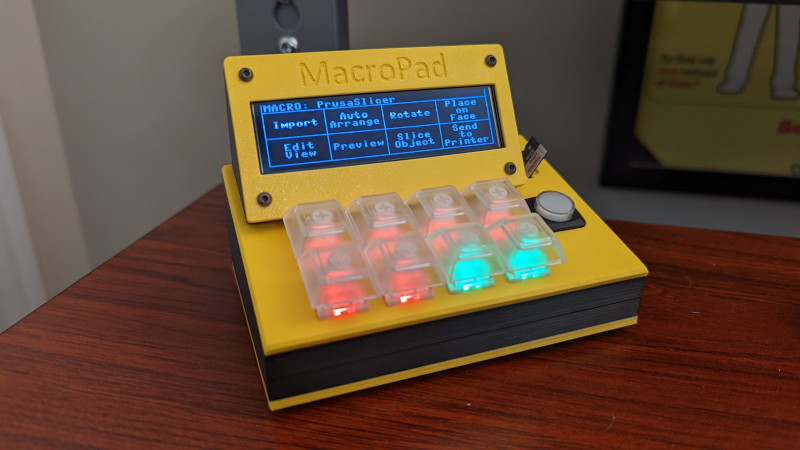Macropads are great to have around for hotkey input, but things can get out of hand pretty quickly when you realize just how many shortcuts are in your life. To avoid ending up with another keyboard-sized keyboard, some hackers will use a handful of switches and a lot of layers to turn a few keys into many. And instead of worrying about legends, they use blank keys and leave the labels to be displayed on some kind of screen.
Among them is [QCJ3], who built this nifty little console-style macropad. Uninterested in managing microcontroller memory, [QCJ3] went the tangible route and loaded various profiles onto a micro SD card. Each text file on a given card holds a label, a color for the keyswitch LED, and of course, the keystrokes that make up the macro itself.
There are myriad ways to build a macro pad, from designing with bare chips (if you can get them) to programming a pre-built key matrix. Grab the files if you like the console look and call it a day, or build a completely new enclosure that fits your hand exactly. Whatever you build, consider entering it in our brand spankin’ new Odd Inputs and Peculiar Peripherals Contest, which runs now through July 4th. If you need more inspiration, just peep the projects under macropad tag, or peruse the much heftier keyboard tag.
Via KBD















Saitek had a couple of programmable keypads for games or anything you wanted to set them up for. The first model connected to a PS/2 port inline between the keyboard and PC. To program it, the setup software printed out a barcode that was read by clamping it into the keypad then sliding a handle across to move the code reader head.
That one will of course still work today, with any OS one chooses to run on a PC, as long as you have something with Windows that can run the software to define and print the codes.
Their second version connected via USB and was programmed through USB, so of course it doesn’t work with newer versions of Windows. IIRC it’s only supported by 95 OSR2 with USB supplement through Windows Me.
A good hack would be software to program it for use with Windows XP and later, as well as Linux, Mac OS etc.
For both of them, custom paper overlays could be printed to fit between the base with all the buttons and the clear top cover.
Looks like Babies First Cyberdeck
I wonder if there is a way to intercept the F keys on a regular keyboard. Then the macros could be stored in files on the host system. Which is probably where they should be.
Look in to autohotkey. That can intercept and remap pretty much any keyboard input.
Most of those “multimedia keyboards” with a few extra buttons, it’s trivial to remap them to other functions. They were a thing on laptops a decade ago too. I frequently use my F Keys for their system assigned functions, so prefer to leave them as they are. Launching browser/email/calculator, or a dead URL support page from dedicated buttons is not real useful when the first three are on my taskbar.
It was a rhetorical question.
I have an Elgato Stream Deck, even though I’m not a streamer. Not cheap exactly, but less than building a one-off macro pad and a whole lot slicker. (But I understand the joy of building your own). I have created custom profiles for all my most complicated and/or most oft used programs. Now if I could just train myself to actually use it more often…